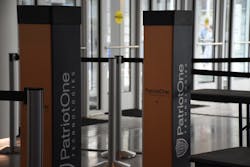A new generation of multi-sensor threat detection devices add to fan security
From a security perspective, the recent Super Bowl at the newly christened SoFi Stadium in Los Angeles was non-eventful. At least that was what the average spectator attending the game and those millions around the world watching it on television and myriad streaming media outlets observed. However, for the security professionals and solutions providers who team up in major sporting and entertainment events like the Super Bowl, there is nothing easy in preparing their game-time strategies.
As sporting venues morph into $5 billion palaces like SoFi and other new venues in professional and college sports, stadiums and arenas are now entertainment sites designed to provide technologically advanced fan experiences. In a game like last month’s Super Bowl where fans shelled out thousands of dollars for the privilege of seeing a championship game and halftime extravaganza, expectations of a safe and secure environment are assumed. Fulfilling those assumptions is not always easy.
New Challenges Can be a Security Nightmare for Sporting Venues
“It's a security nightmare. And it's a security nightmare for a couple of reasons. The expectations of patrons are significantly different than they might have been when the first Super Bowl launched 50 years ago. Society has changed considerably. Our expectations have not only changed given social unrest, mass weapons and (COVID), but all the ills of society (could be on display) with all those hundreds of thousands, millions of people who are going to descend upon Los Angeles. They represent a cross-section of the demographics of all society. If they're fighting against masks (or other issues), you're going to see a magnification of that in a closed and tight environment,” says Peter Evans, CEO of Patriot One Technologies, a company that makes unobtrusive, AI-driven weapons and threat detection systems for stadiums, arenas, casinos, schools, theaters and other businesses.
“The risk probability is much higher. The challenge I have when I think about these kinds of environments is society has changed in 40 years. Yet the technologies that we use to address these problems, the approaches, have not. It's still a labor-based business model that doesn't scale. Think of every other labor-based business model that's been changed (through) digital transformation in the last 10, 15 years; e-commerce and how you buy products online from Amazon versus driving in your car and the non-scalability of that,” adds Evans. “As an example, the prevalent tool that's being used for screening of patrons coming into a venue is a product that’s been around for 40 years. It was built for a time when society was different. When most of us walked around with a leather wallet with some dollar bills in our pocket. Now we’re walking around with smartphones, earbuds, all this edge-based technology on us. However, we're still trying to solve a modern-day problem with a product that was built for a different era and a different society.”
In a recent interview with SecurityInfoWatch.com, Jeff Steel, the Athletic Director of Facility Operations at Auburn University, stated that the role of security has drastically changed. “I think that it's changed significantly in the fact that we're thinking much more out of the box than we did in the past. For the past 20 or 30 years, we didn't think a whole lot about the medical side of it and the possibility of a pandemic. It just seemed so out of character for our thought processes for safety and security. We've also been forced to reassess everything we do and review why we do it, how we do it, and make significant changes in the way we do it based on the pandemic threat. Take something as simple as loading (supplies) in the facility for vendors for either a football game or a basketball game; what was our timeline on that and how did we secure that load? We had to change that approach significantly, particularly early in the pandemic,” he said.
As public health and security necessities collide with an even greater velocity at sporting and entertainment events, a more intense technology approach is being adopted in many venues to help expedite patron screening while maintaining the safety and security of patrons.
Technology Steps Up Its Game
A recent article in Athletic Business magazine, states that an] increased emphasis on screening fans demonstrates a new business methodology. “Through screening, organizations aim to prevent illegal, prohibited and suspicious items from entering the venue and posing a threat to the facility and its occupants. A wide range of metal detectors, X-ray machines and trained staff are employed to create the safest experience possible. While the goal remains the same, emerging technologies offer the promise of accomplishing these objectives with fewer resources, freeing up staff to focus their efforts in other areas and reducing the amount of detection points required to get people safely into the venue.”
According to Evans, it is that fine line of striking the proper balance of technology and security worker that defines how strategic security solutions are being formulated. Like any good technology, he admits that it is only as good as the humans operating and monitoring it.
“It's a challenge because when you look at the staffing for a lot of these venues, these are very transitionary staff. There's like a 30% turnover in most of those staffs, so you've got no consistency in performance, no consistency in staffing,” says Evans. “Technology can only do so much. There's a human in the loop and while technology can do things to minimize the amount of activity and engagement of humans, there will be some human as a final decision-maker. So, people, process and technology have to be designed correctly.”
“If you look at the current technologies in walk-through metal detectors, they beep on metal, very simple, very binary, not a lot of insights. However, there are sensor technologies out there that combined together can tell you things about the reflective property and the types of metals (of objects). With the AI, you can start to correlate that and start to calculate probabilities. There's a high probability that this is a knife, not an iPhone. Now you can start to discern between factors like this is an individual who has a weapon, or this is an individual who doesn't have a weapon. Now you let those who don't have a weapon walk right on in and have a great experience. The (process) helps alleviate the lines, alleviate the pressure, alleviate the frustration of the fan and enables them to have a better fan experience,” Evans explains.
“AI combined with those sensor technologies can give you more digital insights about what's actually happening. Now you can start to take that one step further and use the AI to actually gather more data long before the person gets to the venue. Let's say that you are online and you're buying a ticket. Are you really that person or do we have identity theft? Does this fan have a valid credit card? Have they been banned from the stadium before?” continues Evans. "We can start the patron experience and security background long before you actually enter the venue. I can gather insights and do it in a positive manner. This fan has been here five times. He always sits in the 100 level. Let's send him a message and send him over to the VIP entrance and thank him for his patronship.”
The advanced capabilities of AI-enabled technologies allow for innovative solutions that are being used in today’s stadiums and arenas to transcend traditional analog detectors. These proactive functionalities are providing more actionable insights and layered approaches to security. As Evans points out, it's stealing a page from what cybersecurity has been doing for many years.
“If you think about cybersecurity and the way we used to protect our business networks by building a firewall, it was like a moat around a castle. You either got in or out through the drawbridge. With cybersecurity, they're using all sorts of analytics to create layered approaches to security --multiple layers and concentric rings of security. This is the concept here. By stealing a page from that (approach) and using those same digital insights, we can move beyond just having this one moat called the walkthrough metal detector around the building,” Evans concludes.
About the Author: Steve Lasky is a 34-year veteran of the security industry and an award-winning journalist. He is the editorial director of the Endeavor Business Media Security Group, which includes magazines Security Technology Executive, Security Business and Locksmith Ledger International and top-rated webportal SecurityInfoWatch.com. Steve can be reached at [email protected].







